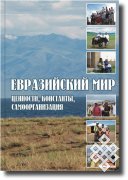 A book co-authored by Russian and Mongolian researchers has been published in Novosibirsk under the title “The Eurasian World: Values, Constants and Self-Organization”. Its executive editor, head of the research team and one of the authors is Professor Yuri Popkov, Deputy Director for Research and Head of the Sector of Ethno-Social Studies at the Institute of Philosophy and Law, the Siberian Branch of the Russian Academy of Sciences.
A book co-authored by Russian and Mongolian researchers has been published in Novosibirsk under the title “The Eurasian World: Values, Constants and Self-Organization”. Its executive editor, head of the research team and one of the authors is Professor Yuri Popkov, Deputy Director for Research and Head of the Sector of Ethno-Social Studies at the Institute of Philosophy and Law, the Siberian Branch of the Russian Academy of Sciences.
The book, rethinking the heritage of the classical Eurasianism, provides an original treatment of a number of important issues, including the values, constants and problems of self-organization of the Eurasian world. The authors base their conclusions on empirical research in different loci of the Eurasian world (Southern Siberia, Kazakhstan, Mongolia, Kalmykia and the Eurasian communities abroad). The book also contains a dictionary of 180 specific tropes and concepts of classical Eurasianism which provide the terminological expression of its distinctive content.
For additional information about the book please contact Yu. Popkov at yuri@philosophy.nsc.ru
THE EURASIAN WORLD: Values, Constants, Self-Organization / Ed. by Yu. V. Popkov — Novosibirsk: Parallel, 2010. 449 p.
CONTENTS
INTRODUCTION
PART I. THE EURASIAN WORLD: CONCEPTUALIZING THE PROBLEM
1.1 «Eevraziistvo» or «eurasianism»?
1.2. The Eurasian problem
1.3. The Eurasian motives of Russian culture
PARTЛ II. VALUES OF THE EURASIAN CULTURE
2.1 The values which built Eurasia
2.2 The will
2.3 Borderline area
2.3.1 The borderline existence
2.3.2 The borderline state
2.4. Mixis
2.5 Kinship
PART III. CONSTANTS OF THE EURASIAN WORLD
3.1. The notion of a constant
3.2. The problem of the middle ground
3.2.1 The polarities and inversions of the Russian spirit
3.2.2 Interpretations of the middle ground
3.3. The numeral archetype
3.4. The flatness of the level country
3.5. The symphonism of the Eurasian process
3.6. The western drift of the anthrostream
PART IV. VALUE ORIENTATIONS OF THE PEOPLES OF INTERNAL EURASIA
4.1. Value orientations of the peoples of Southern Siberia
4.2. Value orientations of the Kazakh and Russian people in the East Kazakhstan Province
4.3. Value orientations of the Mongolian and Russian students in the Big Altay
4.3.1. Stability of traditional values
4.3.2. Similarities and differences of value orientations
4.4. Continuity of generations in the Mongolian society
4.5. The Mongolian life-world
PART V. THE KALMYKS: BETWEEN EAST AND WEST
§ 1. From the history of the Kalmyks: on the beginning of the empire and its understanding
§ 2. The mentality and language of the Kalmyks
§ 3. The experience of acculturation: the Soviet Melting Pot
§ 4. The Kalmyks in the West: the American experience
PART VI. THE BIG ALTAY: LOCUS OF SELF-ORGANIZATION OF THE EURASIAN WORLD
§1. Altay as a Eurasian prototypical territory
§2. The global context of the Altay regional cooperation
§3. The experience of trans-border cooperation in Russia and abroad
§4. The activities of the International Coordination Council “Altay – Our Common Home”: the results and prospects for the future
CONCLUSION
APPENDIXES
Yu. V. Popkov, E.A. Tyugashev. Classical Eurasianism: Paths and Concepts
A.V. Ivanov. The Mongolian Face of Eurasia (Subjective Notes on an Ethno-Sociological Expedition to Mongolia).

